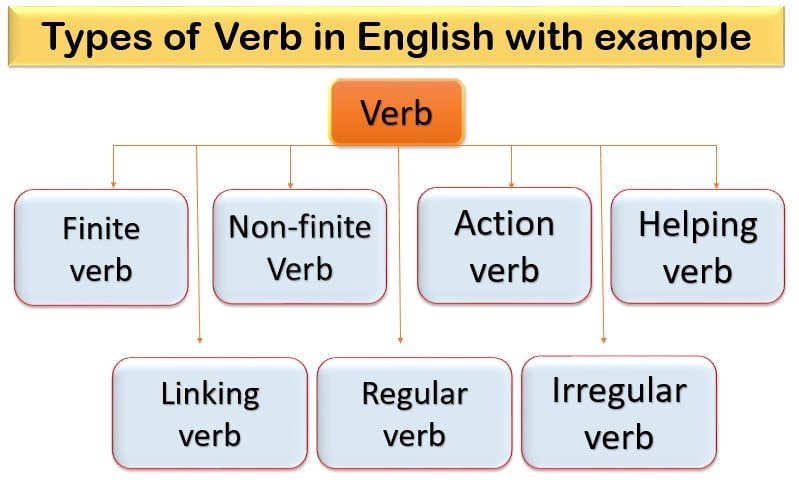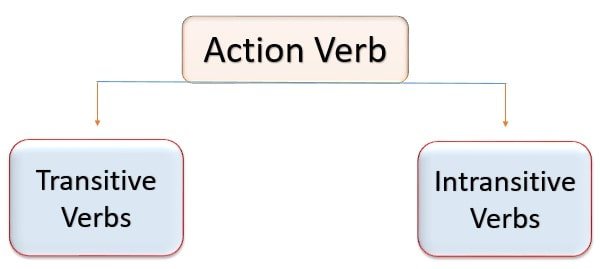Types of verb in English, with examples
In this article, we will learn all 7 kinds/types of verbs in English grammar with examples for class 4, 5, 6, 7, 8, 9, 10, 11, 12, for teachers, students, competitive exams, kids and more, pdf is also provided.
Definition: A verb is the main ingredient of a sentence. No sentence can be completed without a verb. A verb is the action word of the sentence. It tells us what a person or thing, does or possesses.
What is a verb?
In English grammar the Verb is one of the most important parts of a sentence. It is a word or phrase that says or asserts something about a person’s place or a thing.
Examples:
- Radha is a great athlete.
- She runs really fast.
- She has great strength.
Types of verb in English grammar
Verb and its types in English grammar, here we have 7 types of verbs.
- Finite verb – Indicative of number Singular or plural
- Non-finite verb – Used as nouns, adverbs, and adjectives
- Action verb – Talk about what the subject is doing in the sentence
- Helping verb – Help the main verb in a sentence by extending the meaning of the verb
- Linking verb – Connect the subject to a noun or adjective
- Regular verb – Verbs that form their past participle with ‘d’ or ‘ed’
- Irregular verb – Verbs that change their form completely
Read all these verbs in detail with examples
Finite Verbs
Finite verbs are such kinds of verbs that have a definite relation with the subject or noun. Usually, these verbs are the main verb of a clause or sentence and can be changed according to the noun. They are used only in the present and past tense. They can be indicative of number (Singular or plural).
Finite verbs Examples
- He attends his class regularly. (change of person)
- They attend the class regularly (change of person)
- They attended the class regularly (Change of tense)
Non-Finite Verb
Such types of verbs cannot be the main verb of a clause or sentence as they do not talk about the action that is being performed by the subject or noun. And they do not indicate any tense (learn all 12 types of tenses with examples), mood or gender.
We can also use these verbs as nouns, adverbs, and adjectives, these types of verbs are also used to form non-finite clauses which are simply dependent clauses that use non-finite verbs.
Examples of non-finite verb
- He invited his friends to like his post on Facebook. (non-finite verb)
- They invited their friends to like their post on facebook. (non-finite verb)
In the above sentences, the verb ‘to like’ is not affected by the change in tense and number. So, it is a non-finite form of the verb.
More Examples for Non-finite verb
- He loves camping in the woods. (Here, the non-finite verb is ‘camping’ and it is used as a noun.) These kinds of non-finite verbs are called Gerunds.
- I need to go to sleep. (Here, the non-finite verb phrase is to sleep, it is acting as a noun.) Non-finite verbs that use ‘to’ before they are called Infinitives.
- The sleeping dog caused a delay. (Here, the non-finite verb has-ing form and is acting as an adjective.) The non-finite verbs that have ‘-ing’ or ‘ed’ as suffixes and cause the verb to become an adjective are called Participles.
Action Verbs
An action verb is also known as the Main verb, Principal verb, and Lexical verb. All these types of verbs talk about what the subject is doing in the sentence. Action verbs are one of the most easily identifiable types of verbs in English grammar. To identify or recognize these verbs, we simply have to look for the words in the sentence that answers the questions in the sentence. ‘What is the subject doing?’
For Example, Rose is painting the kitchen walls. (What is rose doing?)
There are two types of action verbs in English grammar
- Transitive Verbs
- Intransitive verbs
Transitive Verb
Transitive verbs are such kinds of verbs in which action verbs have a definite object on which, or for which the action is being performed. That means the action has a definite recipient or object.
To identify them, you can ask the question – ‘what is the object being affected by the verb?’
Transitive verbs Example:
Rose is painting the kitchen walls. (What is Rose painting? The kitchen walls.)
Thus, we see that there is a specific object on which the action is done.
Intransitive Verb
These verbs also are shown an action but here there is no specific object on which the action is being done. To recognize these verbs, we ask the question – ‘what is the object being affected by the verb?’ If there is no answer present in the sentence (4 types of sentence in English), we can say the verb in the sentence is an intransitive verb.
Intransitive verb Example:
Rose is painting right now. (What is Rose painting? There is no answer.)
This means that in the sentence, painting is an intransitive verb. An intransitive verb telling us about the action of the subject but there is no specific object for the action.
Helping or Auxiliaries Verbs
An auxiliary (also called Helping, Auxiliaries, or Verbal auxiliary verb), Helping verbs are verbs that, as their name suggests, help the main verb in a sentence by extending the meaning of the verb. These types of verb assist the main verb in showing time and meaning.
2 types of helping verbs in English grammar
- Primary Auxiliaries verb
- Modal Auxiliaries verb
Primary Auxiliaries verb
These verbs function both as helping and main verbs. (be, do, have)
Primary auxiliaries verb Examples
- He is the boss here.
- She hasher own car.
Modal Auxiliaries verb
These verbs are used to change the tone and mood of the main verb.
Can, could, may, might, shall, will, would, should, must and ought to are called modal auxiliaries verbs.
Modal Auxiliaries verbs Examples
- She can run fast.
- You should study English.
Linking or Copular verb
Linking or Copular verbs are unlike other verbs as they do not tell anything about the subject themselves, instead they connect the subject to a noun or adjective that helps in describing or providing additional information about the subject.
It is important to remember that:
The difference between a helping verb and a linking verb is that the linking verb is used to connect the subject with something that describes it. Whereas, the helping verb is used together with an additional main verb to express the action.
Difference between linking verb and helping verb
- I am tall. (linking verb)
- I am running. (helping verb)
In the above example, the same word can be used as a linking verb as well as a helping verb.
Linking verb Examples
- He is the manager. (Here, the verb is ‘is’ adding information to the subject ‘He’.)
- They are naughty children. (Here, ‘are’ is the linking verb joining the subject ‘they’ to the complement ‘naughty children’.)
Regular or weak Verb
Those verbs that form their past participle with ‘d’ or ‘ed’ as suffixes are regular verbs. These verbs do not undergo substantial changes while changing forms between tenses. These verbs are also called weak verbs.
Regular verb Examples
Examples of regular verb according to Present, Past, Past Participle
| Present | Past | Past Participle |
|---|---|---|
| Decay | Decayed | Decayed |
| Amuse | Amused | Amused |
| Command | Commanded | Commanded |
| Explained | Explained | Explained |
| Impress | Impressed | Impressed |
Irregular or strong Verb
Irregular verbs are the verbs that change their form completely when changing from base form to past participle and perfect participle.
Most of the time, they form their past times by a change in the main vowel of the present tense and without the addition of any ending. We cannot tell or predict what form irregular or strong verb is going to take in a changed tense. One has to memorize the changes in the verb forms initially, as later with practice it becomes a matter of habit.
Irregular Verb Examples
| Present | Past | Past Participle |
|---|---|---|
| Run | Ran | Run |
| Awake | Awoke | Awoken |
| Choose | Chose | Chosen |
| Forgive | Forgave | Forgiven |
| Bring | Brought | Brought |



IT IS A GREAT EXPERIENCE TO BE SURFING THE NET AND COME ACROSS SUCH A GREAT RESOURCE. THANK YOU.